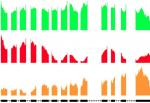Activity 4 shows how spliceforms are important for understanding health and disease. In the example in Activity 4, we mapped all of the reads to the correct spliceform.
But what happens if you have reads that map to multiple spliceforms? Let’s take a step back and look at how sequence modifications introduced in Activities 1—3 can help you figure out which spliceform is the correct alignment.
Click on the image to view the presentation in your web browser or download the PowerPoint slide show (ppsx format). The content in each format is the same.
Discussion Questions
1. In this example, what happens when the read length is doubled? Does knowing the identity of additional bases in your read help you tell whether Spliceform 1 or 2 is correct?
2. In this example, Spliceform 1 has two exons and Spliceform 2 has three exons. Describe the situation in the example where the original read’s paired-end mate still aligns to both spliceforms. In other words, which exon does the mate (in orange) align to in Spliceform 1? Which exon does it align to in Spliceform 2?
3. The paired-end sequence information did not help to tell if either Spliceform 1 or 2 is correct. What additional information was needed to tell us that Spliceform 1 is the correct alignment?


 Discovering the Genome
Discovering the Genome
